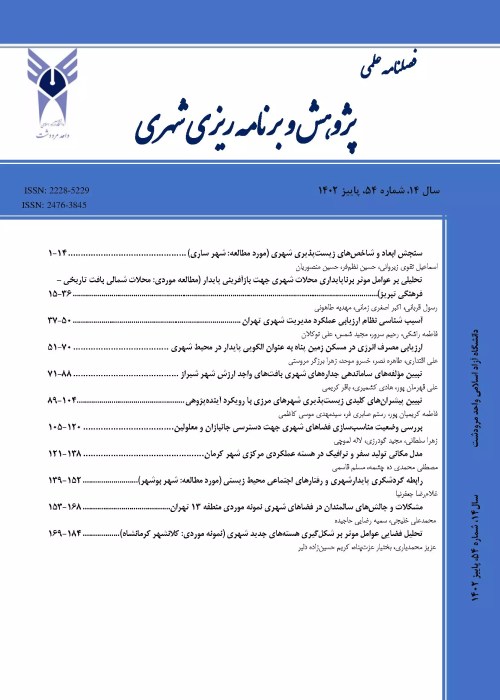An Analysis of the Effects of Nano Concrete On Sustainable Urban Development (Case Study: Shiraz Metropolis)
Many city planners, policymakers and specialists offered a different solution for having a sustainable urban development so far and some of them have been successful to some extent. Using nanotechnology for sustainable urban development is a measure that most experts agree on and nano concrete is one of the most important uses of nanotechnology in this field. Despite the researchers’ focus and emphasis on the use of this technology in urban environments, it has not received much attention. In the spirit of expanding and promoting the use of this modern technology in urban environments and with the goal of analyzing the effects of nano concrete on the sustainable urban development of shiraz metropolis, this study was conducted. The opinions of experts, specialists, professors and other researchers who have enough experience in this field has also been taken into account for this study. The required sources were gathered using survey study and documentary research. Study results show that, according to experts, because of its varied functions in different fields such as improving mechanical resistance, improving concrete’s durability and stability, decreasing permeability, compatibility with the environment and improved resistance against abrasion and impact, the use of nanotechnology in concrete can be effective in sustainable urban development. Pearson’s correlation coefficient results showed that there is a meaningful statistical relationship between the use of nano concrete technology and the sustainable development of Shiraz metropolis. Linear regression results (two variables) showed that the independent variable of nano concrete could explain 0.697% of the changes in the dependent variable (sustainable urban development of Shiraz metropolis).
Today, nanotechnology, as a key technology, has provided many opportunities for sustainable development of urban spaces in a variety of areas, including faster, more flexible, more desirable, more sustainable and more cost-effective construction in the world. A review of existing literature and documents shows that nanotechnology and Nano-concrete technology are theoretically effective in the physical, environmental and even social and economic development of urban spaces. The researchers intend to investigate the effects of Nano-concrete on the sustainable development of urban spaces from the perspective of public and private sector experts. To achieve the above-mentioned goal, field studies have been conducted in Shiraz metropolis, which is one of the most prominent urban areas in the country for the development of nanotechnology and Nano-concrete technology. Therefore, according to the findings, the basic question the researchers in the present study are seeking to analyze and examine is as follows: Can Nano-concrete technology directly affect the sustainable development of Shiraz metropolis? And how does it work?
The results of Pearson correlation coefficient showed that the calculated correlation coefficient of 0.698 was significant at the level of error less than 0.01 and indicated high positive correlation between the two variables. In other words, with the increasing use of nanotechnology and Nano-concrete in the urban development process, the level of sustainable metropolitan development improves, and vice versa. Analysis of the effect of Nano-concrete technology (as an independent research variable) on sustainable urban development in Shiraz metropolitan area (as a research dependent variable) using simultaneous linear regression showed that the values of multiple correlation coefficient, coefficient of determination and adjusted coefficient of determination were 0.698, 0.487 and 0.484, respectively, among which the adjusted coefficient reporting was statistically more logical. Therefore, it can be concluded that the independent variable of Nano-concrete was able to explain 48.4% of the dependent variable (sustainable development of urban spaces in Shiraz metropolis).
The results showed that the viewpoints of experts and specialists in nanotechnology as well as academic professors specializing in civil, architecture, urban planning and urban development, were significantly positive about the application of Nano-concrete technology in urban spaces. This is due to the physical, economic, environmental benefits of applying this new technology to urban spaces. The results also showed that there was a positive and relatively strong statistical relationship between the application of Nano-concrete technology and sustainable urban development in Shiraz metropolitan area. The regression impact factor of the independent variable on the dependent variable of the study with the value of 0.698 was statistically significant. This demonstrates that in both theoretical and empirical aspects, Nano-concrete technology can be used as an effective tool in the development of urban spaces. Therefore, according to the results, the use of Nano-concrete technology in the whole process of construction of urban physical facilities and equipment is recommended. It should be noted that with respect to the significant advantages of Nano-concrete technology in the development of urban spaces, evidence suggests that the use of this technology faces several challenges. Poor policy making in the use of Nano-concrete technology, high cost of the process of procurement of these materials, low technical knowledge of the companies active in the field, poor citizen awareness of the benefits of using these materials in the process of construction in urban areas and poor infrastructure requirements, are among the most important challenges and obstacles to the development of Nano-concrete technology in Shiraz metropolis, that by adopting the measures and executive solutions to tackle the above- mentioned obstacles, a clear perspective can be imagined for further use of this technology in the study area and other cities of the country.
- حق عضویت دریافتی صرف حمایت از نشریات عضو و نگهداری، تکمیل و توسعه مگیران میشود.
- پرداخت حق اشتراک و دانلود مقالات اجازه بازنشر آن در سایر رسانههای چاپی و دیجیتال را به کاربر نمیدهد.


